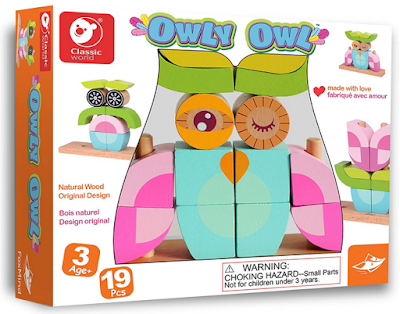 |
| Owly Owl - 14 blocks and 10 patterns |
Lots of visual perceptual and hand skills go into completing Owly Owl models. FoxMind is a brand that I know and trust and I have blogged about many of their products (see list below). Their products are typically logic games that include multiple challenges that increase in difficulty as you go. I consider these types of activities a good value and very useful in therapy.
Owly Owl is a collection of 14 pieces that are placed on a base with 4 dowels to create 10 different models. The pieces are chunky wood and brightly painted. There are two squares and two circles and the rest of the pieces are not symmetrical, so will require a specific spatial orientation. Even the square and circles are painted and will require you to orient them.
The wooden base measures 8" across. There are 4 removable wooden dowels. Two are 3 5/8" long and two are 6 1/8" long.
The 10 patterns are printed on 5 cards, with each card having a different model on each side. The cards measure 3 15/16" square. The models range from 6 pieces to all 14 pieces.
Other FoxMind activities I have blogged about:
- Equilibrio - Build structures upright, some with challenging balance aspects such as the one above that is built on round blocks. 18 pieces, 60 challenges.
- Perspecto - Build structures from a variety of perspectives (up to three views per puzzle). The old name for this game is Cliko. The Perspecto puzzle book is the exact same book as the Cliko book, just a new name. 18 pieces, 55 challenges.
- Architecto - Build structures upright. 18 pieces, 60 challenges.
- Tangramino - Build structures flat on the table. 18 pieces, 64 challenges.
- Smart Cookies - A logic, deductive reasoning, problem solving game with a cookie theme.
- Zoologic - You are a zookeeper trying to avoid chaos among the animals. As you solve puzzles, no animal can be placed next to a rival or next to his favorite food. 60 puzzles.
- Archelino - A beginners logic puzzle. Load the animals onto the ark while pleasing each animal's seating request. 60 beginner challenges.
Try this:
- Start by playing, and/or examining the pieces without building any models from cards so that the individual can get acquainted with the different shapes and views from different perspectives.
- Start with the necessary pieces lying on the table, already in the correct orientation, for beginners. As the individual improves, turn the necessary pieces so that they will need to be flipped and oriented, pile the pieces on the table so that some are partially covered or behind others, and/or add additional unnecessary pieces to sort through. Work on a variety of visual perceptual skills at the same time if the individual is able.
- Hand the individual a block at a time to build if they cannot look at a finished model and tell where to start or how to proceed.
- Try using the work "stack" if the individual wants to start at the top and build down.
- Build a structure while the individual looks on and think out loud about the process as you work. Then let them try to build it.
- Orient and place a piece for the individual as he watches, if he is having difficulty building. Then pick it back up, flip or turn it, and give it back to him to try again.
- Ask the individual "Is that correct?" if a mistake has been made. Let them compare it to the card and allow him time to spot the error and correct it before jumping in to help.
- Hand the individual each piece as he needs it in the incorrect orientation. Ask him to turn it in-hand to position it for placement.
- Find all the pieces for a model ahead of time. Place only those pieces and the card in front of the child. This may decrease frustration that might be added by working on too many things at once.
- Push the first piece or two toward the individual if he is having trouble getting started. Stop assisting as soon as you see he is ready to go it alone.
- Use consistent positional and relational language as you work.
- Work on manual dexterity, in-hand manipulation, visual discrimination, visual closure, visual form constancy, spatial relations/position in space, figure ground, eye-hand coordination, executive functioning skills, process skills, play and leisure exploration and participation
In the box: 14 colored pieces, 5 piece base, 5 pattern cards
If you are interested in purchasing this item or just want more information, click on the image below.



No comments:
Post a Comment
Thank you for taking the time to comment.